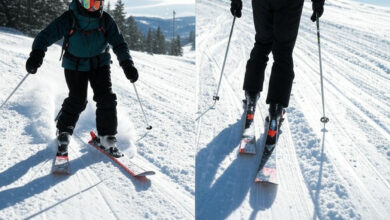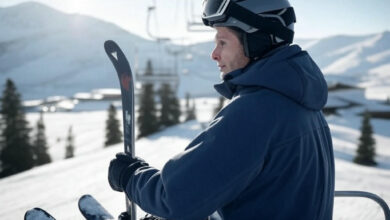Why Are Ski Boots So Heavy?
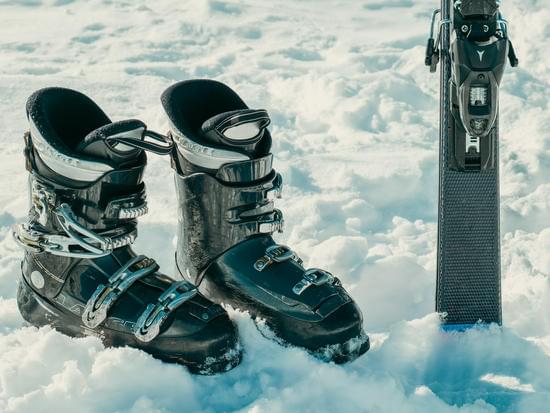
Ski boots are an essential piece of equipment for any skier, but one question often comes up: Why are ski boots so heavy? If you’ve ever lifted a pair of ski boots, you’ve probably noticed they’re significantly heavier than regular shoes or even hiking boots. This weight isn’t just a random design choice—it’s intentional and serves a critical purpose. At The New Ski, we’re here to break down the reasons behind the weight of ski boots, their importance, and how to choose the best ski boots for your needs. Whether you’re a beginner or an experienced skier, understanding why ski boots are heavy will help you make informed decisions about your gear.
“Ski boots are heavy because they are constructed with rigid plastic molds that protect your feet and ankles from extreme forces as you slice through the snow at speed. Their weight also gives you more control, and different types of boots can range in their weight, comfort, and control.”
Contents
- 1 Control To Your Carving
- 2 Construction Meets Protection
- 3 Why Are Ski Boots Heavy?
- 4 6 Main Types of Ski Boot
- 5 Why Aren’t My Ski Boots Comfortable?
- 6 Are Heavy Ski Boots Better?
- 7 How to Choose the Best Ski Boots
- 8 Top 6 Tips For More Comfortable Ski Boots
- 9 Top 4 Tips for Reducing Ski Boot Discomfort
- 10 Conclusion
Control To Your Carving
Carving in ice skating relies on precise edge control. Your skates have an inside and outside edge, and learning to shift your weight smoothly between them is key to making clean, controlled turns. Keep your knees slightly bent, apply pressure on the correct edge, and lean into the turn to create a smooth carving motion without skidding.
Maintaining the right body position is essential for controlled carving. Your upper body should align with your lower body, and your arms should remain relaxed to aid in stability. Engaging your core and keeping your weight centered over the skates ensures that you stay balanced while executing deep turns with confidence.
5. Insulation
Insulation is another key factor in protecting your feet, especially in colder conditions. The insulation inside the shoe or boot helps trap body heat and keeps your feet warm by creating a barrier against the cold. This is especially important in outdoor activities like skiing or hiking, where staying warm is essential for comfort and performance.
6. Waterproofing
Waterproofing is crucial for preventing moisture from entering the shoe or boot, keeping your feet dry in wet conditions. Materials like Gore-Tex or other waterproof membranes are often used to create a barrier against rain, snow, or puddles. This added protection helps to avoid cold, wet feet and discomfort, ensuring your shoes or boots perform well even in challenging weather.
Why Are Ski Boots Heavy?
Ski boots are heavy for several reasons, all of which contribute to their functionality and performance on the slopes. Here’s a detailed look at why ski boots weigh more than your average footwear:
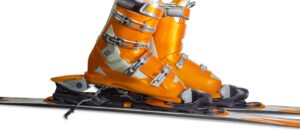
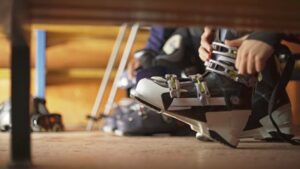
1. Durability and Protection
- Ski boots are designed to withstand extreme conditions, including freezing temperatures, sharp edges, and high-impact forces. They’re made from tough materials like polyurethane and plastic, which add weight but ensure the boots can handle the rigors of skiing.
- The heavy construction also provides protection for your feet and ankles. Skiing involves high speeds and sudden movements, so the boots need to be sturdy enough to prevent injuries. For example, a collision or fall could cause serious harm if the boots weren’t built to absorb impact.
2. Support and Stability
- Ski boots are built to offer maximum support to your feet, ankles, and lower legs. The stiffness of the boots helps transfer your movements to the skis, giving you better control and precision.
- The weight of the boots contributes to their rigidity, which is essential for maintaining balance and stability on uneven terrain. Without this rigidity, your movements would be less precise, making it harder to carve turns or navigate challenging slopes.
3. Insulation and Comfort
- Ski boots are designed to keep your feet warm in freezing conditions. They often include thick insulation layers, which add weight but are necessary for comfort and safety. Cold feet can ruin a day on the slopes, so the extra insulation is a worthwhile trade-off.
- Additionally, the boots have padded liners and footbeds to provide cushioning and reduce fatigue during long days on the slopes. These features ensure that your feet stay comfortable, even after hours of skiing.
4. Attachment to Skis
- Ski boots are specifically designed to attach securely to skis using bindings. The heavy, rigid structure ensures a tight connection, allowing you to control your skis effectively.
- Lighter boots might not provide the same level of responsiveness, making it harder to maneuver on the snow. The weight of the boots ensures that your movements are translated directly to the skis, giving you the precision you need for advanced techniques like carving or mogul skiing.
6 Main Types of Ski Boot
1. Piste Ski Boots
If you’re a beginner or simply prefer sticking to groomed slopes, piste boots are your go-to choice. They prioritize comfort and control on well-maintained trails and sometimes feature a ‘walk’ mode for easier walking when you’re off the slopes. These boots are heavier than some others but offer stability, weighing around 2 kg per boot.
2. Freestyle Ski Boots
Freestyle skiing demands boots that can absorb the shock of jumps, tricks, and quick landings. These boots are more flexible, allowing you to move with ease and absorb impact, but still maintain control when you’re in the air or landing. With an approximate weight of 2 kg per boot, they’re built for action.
3. Freeride Ski Boots
For those who crave adventure both on and off the piste, freeride boots provide a mix of flexibility and support. These boots are lighter, making them perfect for exploring diverse terrains, whether you’re navigating fresh powder or carving through moguls. With a weight of about 1.6 kg per boot, they’re ready for any challenge.
4. Touring/Skimo Ski Boots
Touring and Skimo boots are all about versatility — perfect for ski touring or backcountry skiing. They’re designed with comfort and long climbs in mind, featuring a flexible “walk” mode and a lightweight build for easy movement uphill. Weighing around 1.5 kg per boot, these boots are ideal for those who want to explore the backcountry.
5. Race Ski Boots
Race boots are built for one thing: speed. Stiff, tight, and responsive, these boots offer maximum control at high speeds and during sharp turns. However, they aren’t meant for all-day comfort — they’re made to get you down the hill as quickly as possible. With a weight of around 1.2 kg per boot, they’re all about precision.
6. Cross-Country Ski Boots
Cross-country boots are designed for lightness and mobility, almost like hiking boots for skiing. They give you the flexibility to glide efficiently while still providing ankle and heel support. Weighing only 700g per boot, they are the lightest option, making them perfect for long-distance skiing on flatter terrain.
No matter your skill level or preferred skiing style, there’s a boot designed to enhance your experience on the slopes. The right choice ensures comfort, performance, and enjoyment, so make sure to pick the one that suits your needs.
Why Aren’t My Ski Boots Comfortable?
Ski boots are essential for maintaining control and stability on the slopes, but discomfort is a common complaint for many skiers. There are several factors that can contribute to the discomfort of ski boots, and understanding them can help improve your overall experience on the mountain.
1. Incorrect Fit
One of the most common reasons ski boots are uncomfortable is improper fitting. If the boots are too tight or too loose, they can cause pressure points or lead to blisters. Ski boots should fit snugly but not cause pain. According to ski experts, the ideal boot fit is about a 1-2 finger gap behind the heel when standing upright, but your toes should just brush the front of the boot when you bend forward. This ensures that the boot is secure but not too tight. Boots that are too big can lead to excess movement, while those that are too small can create painful pinching.
2. Boot Stiffness and Flex
Ski boots come in various stiffness ratings, often indicated as flex numbers. A flex rating of 60-70 is considered soft, ideal for beginners or lighter skiers, while advanced skiers may prefer stiffer boots with a flex of 100-130. If your boot’s flex doesn’t match your skill level or skiing style, it can affect comfort.
3. Lack of Proper Insole or Footbed
The insole or footbed inside the boot plays a crucial role in comfort and support. Standard insoles might not provide enough arch support or cushioning for your feet, leading to discomfort. Studies show that custom insoles can reduce foot fatigue by as much as 30% and can be essential for long ski days.
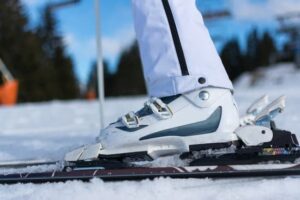
4. Boot Molding and Customization
Most ski boots come with heat-moldable liners, which can be custom-fit to your feet for a more comfortable experience. If your ski boots aren’t molded to your feet properly, it can lead to discomfort. A good fitting process can make a significant difference, with some users reporting a 60-70% increase in comfort after proper boot customization.
By addressing these factors and making sure your ski boots are well-fitted, properly adjusted, and the right match for your skill level, you can greatly improve your comfort and performance on the slopes.
Are Heavy Ski Boots Better?
While heavy ski boots offer several advantages, they’re not necessarily “better” for everyone. The ideal weight of your ski boots depends on your skiing style, skill level, and personal preferences:
- Beginners: Lighter boots can be more comfortable and easier to walk in, making them a good choice for those still learning. Beginners don’t need the same level of precision and control as advanced skiers, so a lighter boot can help them focus on mastering the basics.
- Advanced Skiers: Heavier boots provide the support and precision needed for aggressive skiing, such as carving or off-piste adventures. Advanced skiers often prefer the added weight because it enhances their ability to perform complex maneuvers.
- Touring Skiers: For backcountry skiing, lighter boots are often preferred because they reduce fatigue during long hikes. Touring skiers need to balance performance with weight, as they’ll be walking or climbing in their boots for extended periods.
At The New Ski, we recommend considering your skiing style and goals when choosing between heavy and lightweight boots. Both options have their place, and the best choice depends on your individual needs.
How to Choose the Best Ski Boots
When selecting the best ski boots, consider the following factors to ensure they meet your needs:
1. Fit and Comfort
- Ski boots should fit snugly without causing pain. Look for boots with adjustable features like buckles and heat-moldable liners for a customized fit.
- Try on multiple pairs and walk around in them to test their comfort. A proper fit is crucial for both performance and enjoyment on the slopes.
2. Flex Rating
- The flex rating indicates how stiff the boots are. Beginners should opt for softer boots (lower flex rating), while advanced skiers may prefer stiffer boots (higher flex rating) for better control.
- For example, a flex rating of 60-80 is ideal for beginners, while advanced skiers might choose boots with a rating of 100 or higher.
3. Weight
- Consider the weight of the boots based on your skiing style. Heavier boots are great for downhill skiing, while lighter boots are better for touring or casual skiing.
- If you’re unsure, consult with a professional boot fitter to find the right balance between weight and performance.
4. Insulation and Warmth
- Ensure the boots have adequate insulation to keep your feet warm in cold conditions. Look for features like removable liners for added comfort.
- Some boots also come with heating elements or moisture-wicking materials to enhance warmth and comfort.
5. Durability
- Check the materials and construction of the boots to ensure they’re built to last. High-quality materials may add weight but will provide better performance and longevity.
- Investing in durable boots can save you money in the long run, as they’ll withstand years of use on the slopes.
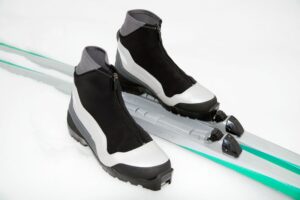
Top 6 Tips For More Comfortable Ski Boots
1. Unclip Your Straps
When you’re taking a break or walking around off the slopes, unclip your ski boot straps to give your feet some breathing room. This simple trick will relieve any pressure, making it more comfortable before heading back on the mountain.
2. Moulded Insoles
To get the best fit and support, invest in custom-moulded insoles. These will contour to the unique shape of your feet, offering more comfort and better foot alignment, reducing pain from pressure points and improving overall comfort.
3. Wear Proper Ski Socks
Choose socks made specifically for skiing, and avoid cotton. Ski socks should be moisture-wicking, breathable, and properly fitted. Avoid socks that are too thick or too thin, as this can lead to discomfort or blisters. Proper socks help keep your feet dry and warm, preventing friction and discomfort.
4. Adjust Your Buckles
Make sure your ski boot buckles are neither too tight nor too loose. You want a snug fit for control, but too much pressure can cause discomfort. Adjust the buckles as needed throughout the day to avoid cramping or pressure spots, especially if your feet swell.
5. Boot Fit and Size Matter
Ski boots should fit snugly but not painfully tight. If your boots are too big, your feet will move too much, causing blisters. If they’re too small, you’ll experience painful pinching. Visit a boot fitter to ensure you have the right size and shape for your foot.
6. Take Breaks and Stretch
Skiing is physically demanding, and your feet are working hard too. Don’t forget to take short breaks and stretch your feet and calves to prevent stiffness. Taking the time to reset your feet during your ski day can keep discomfort at bay and enhance your overall skiing experience.
Top 4 Tips for Reducing Ski Boot Discomfort
While ski boots are inherently heavy, there are ways to make them more comfortable:
- Break Them In: Wear your boots around the house before hitting the slopes to soften the liners and adjust to the fit.
- Use Custom Insoles: Replace the stock footbeds with custom insoles for better support and comfort.
- Adjust the Buckles: Don’t overtighten the buckles—this can restrict circulation and cause discomfort.
- Layer Socks Wisely: Wear thin, moisture-wicking socks to prevent blisters and keep your feet dry.
At The New Ski, we believe that comfort is key to enjoying your time on the mountain. By following these tips, you can minimize discomfort and focus on having fun.
Conclusion
Ski boots are heavy for a reason. Their weight is a result of the materials, design, and features that make them durable, supportive, and functional on the slopes. While heavy boots are ideal for advanced skiers who need precision and control, lighter options are available for beginners and touring enthusiasts. When choosing the best ski boots, prioritize fit, comfort, and performance to ensure a great skiing experience.
So, the next time you pick up a pair of ski boots and feel their weight, remember: it’s all part of what makes them so effective at keeping you safe and in control on the mountain. At The New Ski, we’re here to help you find the perfect boots for your next adventure.



